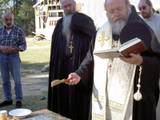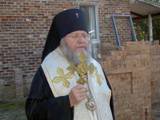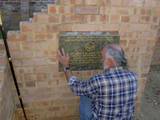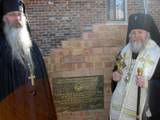1 May 08: Commemoration of commencement of reconstruction of St John the Baptist Skete, Kentlyn
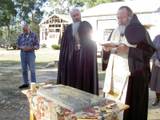 On Bright Tuesday, April 16/29 April, 2008, His Grace Archbishop Hilarion blessed a granite plaque commemorating the commencement of the rebuilding and restoration of St John the Baptist Skete, Kentlyn.
On Bright Tuesday, April 16/29 April, 2008, His Grace Archbishop Hilarion blessed a granite plaque commemorating the commencement of the rebuilding and restoration of St John the Baptist Skete, Kentlyn.
The Skete was founded in 1960 by Monk Guri, a Russian refugee from China. Construction of the first and only Skete building began in 1965, and was never completed. Father Guri died in 1992. In 1999 Archbishop Hilarion asked Hieromonk Joachim to come to Kentlyn and try and re-establish the Skete. After many years of fundraising the first bricks have been laid. The rebuilding is a work in progress and parishes and members of the Diocese of Sydney, Australia and New Zealand are encouraged to assist Father Joachim in his labours through their prayers, donations and practical support. Carpenters are particularly needed at this time to help convert a shed into temporary living quarters for Father Joachim whilst the Skete building is rebuilt.
Saint John the Baptist Skete, Kentlyn
Origins
In 1956 the then head of the Sydney, Australia and New Zealand Diocese of the Russian Orthodox Church Outside Russia (ROCOR), Archbishop Sava, commissioned Hieromonk Dimitry (Obuhoff) to establish a monastery at Kentlyn (near Campbelltown, SW Sydney) on land donated by Protodeacon Peter Grishaev. The Archbishop recruited three candidates to test their vocation to the monastic life with Father Dimitry, and on the 16th of September 1956 the first Divine Liturgy was celebrated.
Sadly, by March 1959 Father Dimitry had been transferred to care for the Russian parish at Geelong, Victoria; two of the novices returned to secular life, and the third, Michael Sorokhin, was left in charge of the Diocesan workshop and candle factory in an adjoining rugged and densely timbered sandstone property that later became Saint John the Baptist Skete.
Monk Guri
On the 5th of October 1960 Monk Guri (Demidov), recently arrived as a refugee from the Russian community in Harbin, China, came to Kentlyn and took up residence at Saint John the Baptist Skete. Living in a small one room tin hut surrounded by thick bush he became its first, and sadly, only monastic inhabitant.
Father Guri was devoted to prayer, and craved a life of solitude, which he found in the 18 hectare grounds of the Skete, often attending daily services at the nearby Convent of Our Lady of Kazan.
Father Guri’s Cave
In his search for silence, and in imitation of the monastic hermits of the Egyptian and Judean deserts, the Holy Mount Athos and the vast forests of Russia, Father Guri cleared out a natural cleft in a nearby sandstone rock face, making a small, cramped cave in which he would spend many hours reading prayers and using his prayer rope. This was his favourite retreat after communing at the Divine Liturgy. Only God and the holy Angels were witnesses to his prayerful vigils and struggles.
His Love of the Holy Fathers
Father Guri was reputed to have had an extensive library on the ascetic life and hesychastic prayer (the use of the Jesus Prayer – also called the Prayer of the Heart – `Lord Jesus Christ, Son of God, have mercy on me, a sinner’ – the foundation of Orthodox Christian ascetic prayer).
He would often laboriously copy excerpts from the writings of the Holy Fathers on the ascetic and spiritual life in small school exercise books. These anthologies, the fruit of his prayerful reading and spiritual struggles, he would give away as a blessing to those whom he felt would benefit from the wisdom of the Holy Fathers.
Father Guri’s Solitary Labours and Repose
Over the succeeding years Father Guri laboured with Michael Sorokhin, together with volunteers from the Russian Orthodox community in Sydney, to erect a small brick building containing six monastic cells surrounding a large central room that was intended to be part of a large monastic church dedicated to Saint John the Baptist. It was not to be completed. He waited alone, praying that others would join him.
Old age eventually forced Father Guri to move from his beloved isolation at the Skete to a small hut in the Convent grounds, and finally to the Saint Sergius Nursing Home, Cabramatta. He died in deep old age at 98 years on the 23rd of August 1992. This faithful monk is buried in Rookwood Cemetery, Sydney.
While the nearby Diocesan workshop and the candle factory continued to function, the unfinished Skete building was used for a time as a printing facility, finally being abandoned. Uninhabited for over a decade the building fell derelict, a nesting place for birds, a home for possums and vermin, damaged by vandals and in a serious state of disrepair.
A New Beginning
In 1999 Hieromonk Joachim received a canonical release from the Serbian Orthodox Church to the ROCOR. He was invited by the current diocesan bishop, Archbishop Hilarion, to rebuild the Kentlyn Skete and restore coenobitic monastic life, as well as providing a base for missionary work amongst English speaking Australians.
With the help of a very small group of faithful volunteers, the past nine years have seen the neglected grounds cleared of decades of rubbish and undergrowth, the Skete building secured and made temporarily habitable and weatherproof. There is now modest accommodation, an office, dining room and, most importantly, a prayer room or chapel where the monastic labour of the Hours of prayer according to the typicon of the Orthodox Church are said daily.
Worshipping in English
With the blessing of Abbess Evpraxia, Father Joachim has been permitted the use of the old monastery Church of All Saints in the neighbouring Our Lady of Kazan Monastery. A small congregation from various national backgrounds – Russian, Cypriot, Greek, Palestinian, Serbian, Lebanese, and Australian converts – attend the Divine Liturgy served in English every Sunday and on major feast days.
Father Guri’s Cave Renewed
Father Guri’s small cave, scene of his many hidden vigils and spiritual struggles, has been cleaned of the dirt and rubbish accumulated since his departure. A floor has been laid, overhanging rock walls strengthened, and icons and a burning lampada installed. Sanctified by Father Guri’s prayers and tears, this sandstone cleft, the Skete’s first ’church’, has become a place of pilgrimage and quiet prayer for growing numbers of visitors to the Skete. Refurbishment of the cave and it’s surrounds is part of the long-term rebuilding programme at the Skete, particularly to protect it from continuing vandalism.
Following Father Guri’s Example
Where Father Guri would record by hand in exercise books the results of his prayerful reading, the Skete now publishes an English language monthly journal – ‘The Voice’ – using the benefits of contemporary computer technology and desktop publishing. Following Father Guri’s example, it is a modest attempt to make the treasures of the Orthodox faith available to Australian Orthodox Christians and enquirers. Now in its seventh year of publication ‘The Voice’ remains Australia’s only monthly Orthodox periodical.
Our Goal – Rebuilding the Skete
The first priority when Father Joachim arrived at Kentlyn was to make the Skete habitable, remove tons of accumulated rubbish and clearing the surrounding bush to reduce the threat of bushfires. While cautious and economical expense has been used to make the old building liveable – the main endeavour has always been to raise funds to rebuild.
Mr Nicholas Proskurin of Leda Building Plans P/L has kindly prepared the architectural plans for the rebuilding of the Skete. Building approval has been given by Campbelltown City Council.
The proposed scheme incorporates the original structure from Father Guri’s time. Keeping faithful to the spirit of the original plans, the large central room will become the nave of the monastery church dedicated to Saint John the Baptist, with the eastern wall removed to build on an altar area. The walls will be raised to allow a new roof with cupola and a wooden floor will be installed.
Attached to the church and monastic cells will be a new extension comprising an office/library cum reception area, a trapeza (monastic dining room), kitchen, storeroom, laundry and ablution area.
The design is modest, practical and economical. With the exception of the Church, the whole area, including the existing small monastic cells, is comparable to a normal suburban house.
Even so, building costs make an immediate start impossible – our savings and the funds raised by a small group of supporters over the past nine years has not yet amounted to even 20% of the total needed.
An Invitation to Help
Orthodox Christians who value traditional Orthodox monastic life and the vital importance in plays in the life of the church are invited to help Hieromonk Joachim rebuild the Skete, and complete what Father Guri began 48 years ago.
If Orthodox monasticism is to grow and flourish in Australia then there must be Orthodox monasteries.
In helping to rebuild Saint John the Baptist Skete, you will also be participating its missionary endeavours. His Grace Archbishop Hilarion is convinced of the necessity for Orthodox Christian evangelism in Australia. With his blessing Saint John the Baptist Skete hopes to provide a place of silence, worship, prayer, pilgrimage, retreat, hospitality, and counsel. There are plans to expand the Skete’s publishing activities.
Orthodox Christians of good will are asked to generously contribute and support our efforts.
St John the Baptist Skete
PO Box 321x
Leumeah NSW 2560Tel: (02) 46263945
email: kosovo_au@yahoo.com.au
The Divine Liturgy is celebrated in English each Sunday at 8.30 am in the old monastery church of All Saints, Smith Street, Kentlyn (near Campbelltown, South West Sydney) – Molieben and Akathist to the Theotokos is served every Tuesday evening in All Saints Church at 7.00 pm. Prayer requests welcome.
Visitors to the Skete and Father Guri’s cave are always welcome. Please phone ahead of your arrival.
Subscribe to ‘The Voice’ – the Skete’s monthly Orthodox journal – AU$25.00 per annum. Send your details to the above address.

 Sts Cyril and Methodius Orthodox Institute
Sts Cyril and Methodius Orthodox Institute
